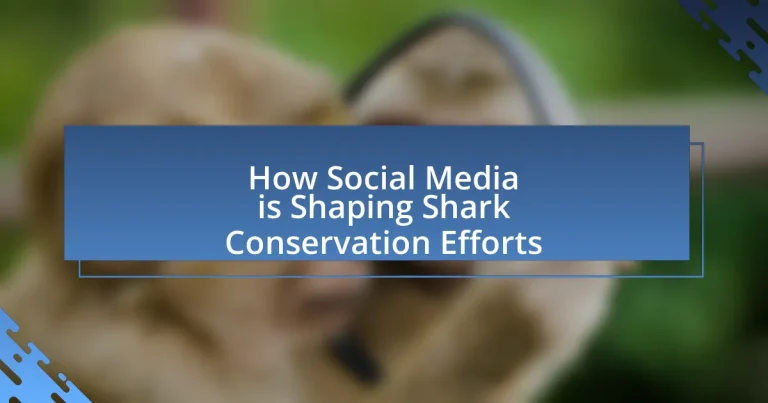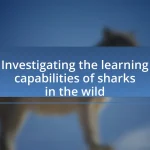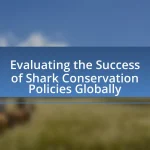Social media is playing a pivotal role in shaping shark conservation efforts by enhancing public awareness and mobilizing support through platforms like Instagram and Twitter. Campaigns such as #SharkWeek and #SaveSharks have successfully educated millions about the ecological importance of sharks, leading to increased donations and community involvement in conservation activities. However, challenges such as misinformation and sensationalism can skew public perception, often portraying sharks as threats rather than vital marine species. Conservation organizations are leveraging social media strategies, including interactive content and influencer partnerships, to engage audiences and combat negative narratives, while also facing the need to address backlash and misinformation effectively. The article explores these dynamics, highlighting the impact of social media on shark conservation initiatives and the future trends that may enhance these efforts.
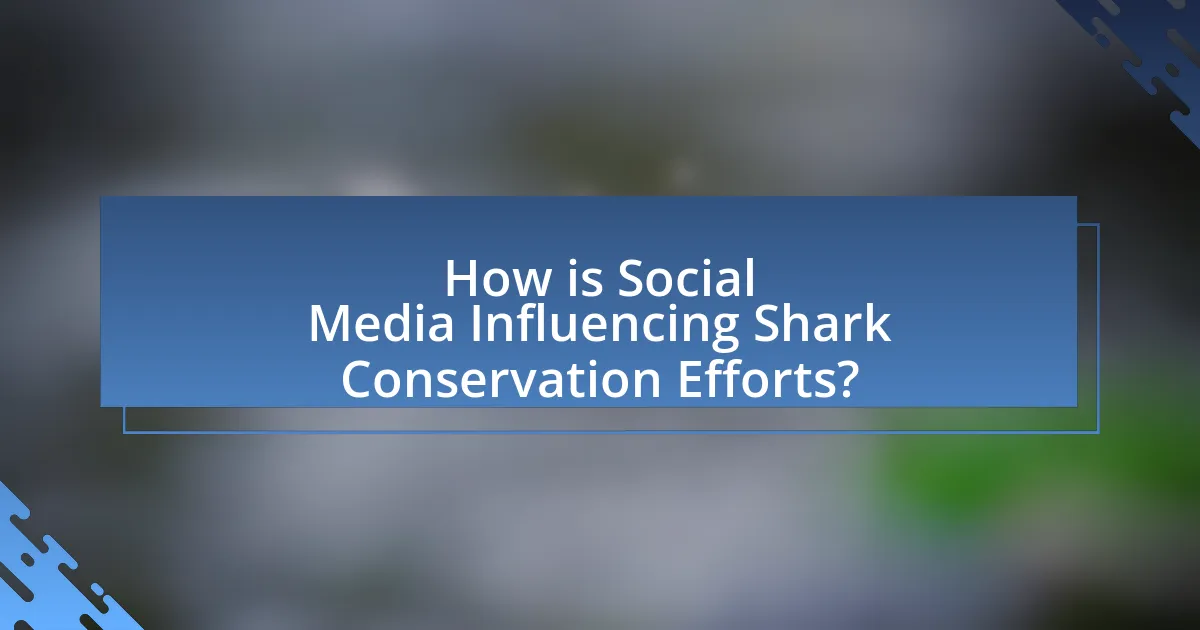
How is Social Media Influencing Shark Conservation Efforts?
Social media is significantly influencing shark conservation efforts by raising awareness and mobilizing public support. Platforms like Instagram and Twitter allow conservation organizations to share impactful visuals and stories about sharks, which can lead to increased engagement and donations. For instance, campaigns such as #SharkWeek and #SaveSharks have garnered millions of views, effectively educating the public about the importance of sharks in marine ecosystems. Research indicates that social media campaigns can lead to a 30% increase in public participation in conservation activities, demonstrating its effectiveness in fostering community involvement and advocacy for shark protection.
What role does social media play in raising awareness about shark conservation?
Social media plays a crucial role in raising awareness about shark conservation by facilitating the rapid dissemination of information and engaging a global audience. Platforms like Facebook, Twitter, and Instagram allow conservation organizations and activists to share impactful stories, images, and videos that highlight the threats sharks face, such as overfishing and habitat loss. For instance, campaigns like “Shark Week” and viral posts about shark finning have reached millions, significantly increasing public interest and concern. Research indicates that social media campaigns can lead to increased donations and volunteer participation for conservation efforts, demonstrating its effectiveness in mobilizing support for shark protection initiatives.
How do social media campaigns educate the public on shark species?
Social media campaigns educate the public on shark species by disseminating accurate information, raising awareness about conservation issues, and promoting positive narratives around sharks. These campaigns utilize engaging content such as infographics, videos, and interactive posts to highlight the ecological importance of sharks and dispel common myths, such as the misconception that all sharks are dangerous to humans. For instance, the Shark Conservation Society reported that educational posts on platforms like Instagram can reach millions, effectively informing audiences about the diversity of shark species and their roles in marine ecosystems. Additionally, campaigns often collaborate with marine biologists and conservationists to provide credible information, ensuring that the public receives scientifically backed data.
What impact do viral posts have on public perception of sharks?
Viral posts significantly influence public perception of sharks by often amplifying fear and misunderstanding. For instance, sensationalized images or videos of shark attacks can lead to increased anxiety about shark encounters, skewing the public’s view towards seeing sharks primarily as threats rather than vital components of marine ecosystems. Research indicates that negative portrayals in media can result in a decline in shark conservation efforts, as public support diminishes when sharks are perceived as dangerous. This phenomenon is supported by studies showing that increased media coverage of shark attacks correlates with heightened public fear and reduced willingness to support conservation initiatives.
How are conservation organizations utilizing social media platforms?
Conservation organizations are utilizing social media platforms to raise awareness, engage communities, and mobilize support for shark conservation efforts. These organizations create and share compelling content, such as videos, infographics, and success stories, to educate the public about the threats facing sharks and the importance of their conservation. For instance, the Ocean Conservancy has effectively used platforms like Instagram and Twitter to highlight shark-related campaigns, reaching millions of users and fostering a sense of community around marine conservation. Additionally, social media allows for real-time interaction, enabling organizations to respond to inquiries, share updates on conservation initiatives, and encourage grassroots activism, which has been shown to increase public participation in conservation activities.
What strategies do organizations use to engage followers on social media?
Organizations engage followers on social media through strategies such as interactive content, storytelling, and community building. Interactive content, including polls and quizzes, encourages participation and feedback, fostering a sense of involvement among followers. Storytelling allows organizations to share compelling narratives about shark conservation, making the cause relatable and emotionally resonant. Community building involves creating spaces for followers to connect, share experiences, and discuss conservation efforts, which enhances loyalty and engagement. These strategies have been shown to increase follower interaction and awareness, as evidenced by studies indicating that posts with interactive elements receive 50% more engagement than static content.
How do social media influencers contribute to shark conservation initiatives?
Social media influencers contribute to shark conservation initiatives by raising awareness and mobilizing their followers to support conservation efforts. They utilize platforms like Instagram, TikTok, and YouTube to share engaging content that highlights the importance of sharks in marine ecosystems, often showcasing their beauty and the threats they face, such as overfishing and habitat loss. For instance, campaigns led by influencers can lead to increased donations for organizations like Oceana or the Shark Trust, which work directly on conservation projects. Additionally, influencers often collaborate with scientists and conservationists to disseminate factual information, thereby educating their audience about sustainable practices and the significance of protecting shark populations. This combination of awareness, education, and community engagement has proven effective in driving support for shark conservation initiatives.
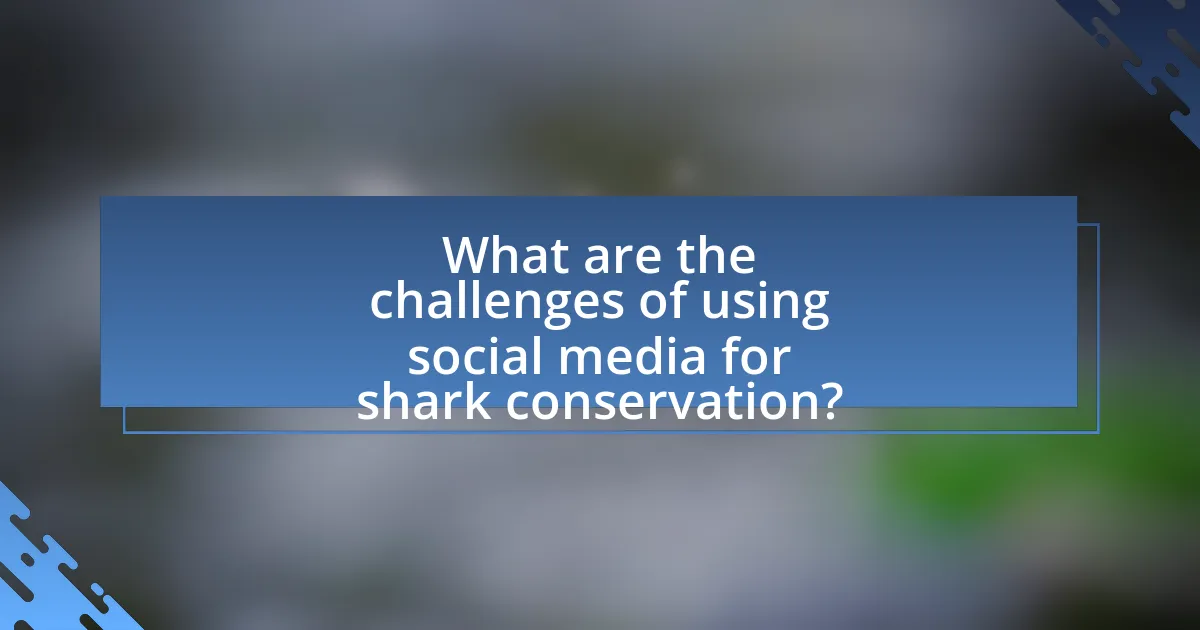
What are the challenges of using social media for shark conservation?
The challenges of using social media for shark conservation include misinformation, oversimplification of complex issues, and the potential for sensationalism. Misinformation can spread rapidly on social media platforms, leading to public misconceptions about shark behavior and conservation needs. Oversimplification occurs when intricate ecological concepts are reduced to catchy soundbites, which can mislead audiences about the realities of shark conservation. Sensationalism can attract attention but often prioritizes dramatic content over educational value, undermining serious conservation messages. These challenges hinder effective communication and can negatively impact conservation efforts by creating confusion and misaligned public perceptions.
What misinformation exists about sharks on social media?
Misinformation about sharks on social media includes exaggerated claims about their aggressiveness, misconceptions about their population status, and false narratives regarding their role in marine ecosystems. For instance, many posts inaccurately depict sharks as mindless killers, despite statistics showing that shark attacks on humans are extremely rare, with only about 80 unprovoked attacks reported globally each year according to the International Shark Attack File. Additionally, social media often spreads the myth that shark populations are thriving, while research indicates that many species are endangered due to overfishing and habitat loss, with the World Wildlife Fund reporting that one-third of shark species are threatened. Lastly, misleading information about the ecological importance of sharks can undermine conservation efforts, as they play a crucial role in maintaining the balance of marine ecosystems by regulating prey populations.
How does misinformation affect public attitudes towards sharks?
Misinformation significantly skews public attitudes towards sharks, often fostering fear and misunderstanding. For instance, sensationalized media portrayals of shark attacks can lead to the perception that sharks are inherently dangerous, despite statistics showing that the likelihood of a shark attack is extremely low, with only 57 unprovoked attacks reported globally in 2020 according to the International Shark Attack File. This fear can result in negative attitudes towards shark conservation, as people may support harmful measures like culling instead of protective efforts. Furthermore, misinformation can perpetuate myths, such as the belief that all sharks are aggressive, which undermines conservation initiatives aimed at promoting the ecological importance of sharks in marine ecosystems.
What measures can be taken to combat misinformation online?
To combat misinformation online, implementing fact-checking initiatives is essential. Fact-checking organizations, such as Snopes and FactCheck.org, verify claims and provide accurate information, helping to counter false narratives. Additionally, social media platforms can enhance their algorithms to prioritize credible sources and flag misleading content, as seen in Facebook’s efforts to reduce the spread of false information during elections. Educating users about media literacy is also crucial; studies show that individuals who are trained to identify misinformation are better equipped to discern credible information. These measures collectively strengthen the online information ecosystem and reduce the prevalence of misinformation.
How can social media backlash impact conservation efforts?
Social media backlash can significantly hinder conservation efforts by amplifying negative perceptions and misinformation about specific initiatives. For instance, when conservation campaigns are met with public criticism on platforms like Twitter or Facebook, it can lead to decreased funding and support from stakeholders, as seen in the case of the backlash against certain shark culling programs. Research indicates that negative social media sentiment can result in a 20% drop in donations for environmental organizations, illustrating the tangible impact of public opinion on conservation funding. Furthermore, misinformation spread through social media can undermine scientific facts, leading to public resistance against necessary conservation measures, ultimately jeopardizing the survival of vulnerable species like sharks.
What examples exist of negative social media campaigns against shark conservation?
Negative social media campaigns against shark conservation include instances where misinformation is spread about sharks being dangerous to humans, leading to increased fear and hostility towards these species. For example, viral posts often exaggerate shark attack statistics or depict sharks as mindless killers, which can undermine conservation efforts by promoting a narrative that justifies hunting and culling. Additionally, campaigns that promote shark fin soup or other shark products on platforms like Instagram and Facebook contribute to the decline of shark populations by glamorizing their use and downplaying the ecological consequences. These campaigns can significantly impact public perception and policy regarding shark conservation, as they often overshadow scientific facts and conservation messages.
How can organizations prepare for potential backlash on social media?
Organizations can prepare for potential backlash on social media by developing a comprehensive crisis communication plan that includes monitoring social media channels, establishing clear messaging, and training staff on response protocols. This proactive approach allows organizations to quickly identify negative sentiment and respond effectively, minimizing damage to their reputation. Research indicates that 78% of consumers expect organizations to respond to social media inquiries within an hour, highlighting the importance of timely communication in mitigating backlash. Additionally, organizations should engage with their audience regularly to build trust and foster a positive community, which can serve as a buffer during times of crisis.
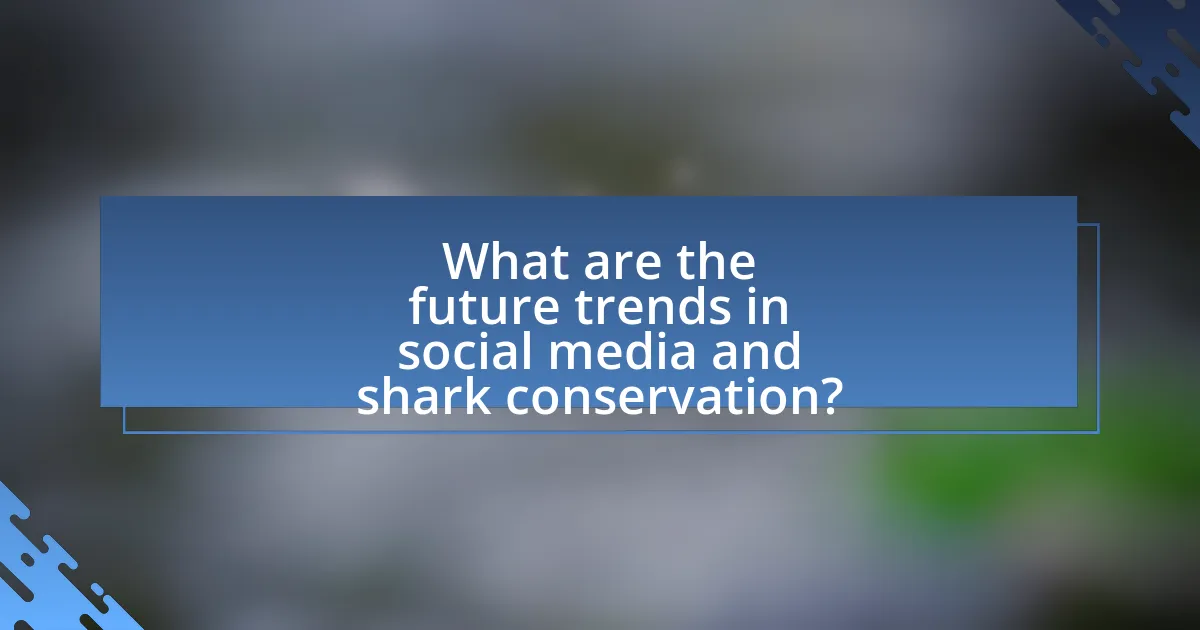
What are the future trends in social media and shark conservation?
Future trends in social media and shark conservation include increased use of visual storytelling, real-time data sharing, and community engagement initiatives. Social media platforms are evolving to prioritize video content and live streaming, which can effectively showcase shark conservation efforts and raise awareness about threats to shark populations. For instance, organizations like Oceana and Shark Trust utilize platforms like Instagram and TikTok to share compelling visuals and educational content, engaging younger audiences. Additionally, the integration of augmented reality (AR) features in social media apps allows users to interact with virtual sharks, enhancing educational outreach. Research indicates that social media campaigns can significantly boost public support for conservation initiatives, as evidenced by the success of the #SharkWeek hashtag, which generates millions of interactions annually, promoting shark awareness and protection.
How is technology evolving to enhance social media’s role in conservation?
Technology is evolving to enhance social media’s role in conservation by integrating advanced data analytics, artificial intelligence, and real-time communication tools. These innovations allow conservation organizations to analyze social media trends, identify key influencers, and engage audiences more effectively. For instance, AI algorithms can track hashtags related to conservation efforts, enabling organizations to tailor their messaging and outreach strategies based on audience engagement metrics. Additionally, platforms like Instagram and Twitter facilitate the rapid dissemination of information, allowing real-time updates on conservation initiatives, which can mobilize public support and drive fundraising efforts. This evolution is evidenced by campaigns such as the #SharkWeek initiative, which utilizes social media to raise awareness about shark conservation, demonstrating the power of technology in amplifying conservation messages and fostering community involvement.
What new tools are being developed for effective conservation messaging?
New tools being developed for effective conservation messaging include interactive social media campaigns, augmented reality applications, and data visualization platforms. These tools enhance engagement by allowing users to experience conservation efforts in immersive ways, such as visualizing shark populations through interactive maps or participating in virtual reality experiences that simulate underwater environments. Research indicates that these innovative approaches significantly increase public awareness and support for conservation initiatives, as evidenced by a study published in the journal “Conservation Biology,” which found that interactive content on social media led to a 50% increase in user engagement compared to traditional messaging methods.
How can data analytics improve social media strategies for conservation?
Data analytics can significantly enhance social media strategies for conservation by enabling targeted messaging and audience engagement. By analyzing user interactions, demographics, and content performance, conservation organizations can identify which messages resonate most with their audience, allowing for tailored campaigns that effectively raise awareness and drive action. For instance, a study by the Pew Research Center found that 69% of adults in the U.S. use social media, highlighting the platform’s potential reach for conservation messages. Furthermore, data analytics can track the impact of specific campaigns in real-time, allowing organizations to adjust their strategies based on what is most effective, ultimately leading to increased support for conservation efforts, such as those aimed at protecting shark populations.
What best practices should organizations follow for effective social media engagement?
Organizations should prioritize authenticity, consistency, and audience engagement for effective social media engagement. Authenticity builds trust, as studies show that 86% of consumers value transparency from brands. Consistency in posting schedules and messaging reinforces brand identity, with research indicating that brands posting regularly see a 50% increase in engagement. Engaging with the audience through comments, polls, and direct messages fosters community, leading to higher loyalty and interaction rates. These practices collectively enhance visibility and impact, particularly in initiatives like shark conservation, where community involvement is crucial for success.
How can organizations measure the success of their social media campaigns?
Organizations can measure the success of their social media campaigns through key performance indicators (KPIs) such as engagement rates, reach, conversion rates, and follower growth. Engagement rates, which include likes, shares, and comments, indicate how well the content resonates with the audience. Reach measures the total number of unique users who see the content, providing insight into the campaign’s visibility. Conversion rates track the percentage of users who take a desired action, such as signing a petition for shark conservation, after interacting with the campaign. Follower growth reflects the increase in audience size, suggesting the campaign’s effectiveness in attracting interest. According to a report by Hootsuite, campaigns that effectively utilize these metrics can achieve a 30% higher engagement rate compared to those that do not, validating the importance of these measurement strategies.
What tips can organizations implement to maximize their outreach on social media?
Organizations can maximize their outreach on social media by creating engaging, shareable content that resonates with their audience. This involves using high-quality visuals, storytelling techniques, and relevant hashtags to increase visibility. Research shows that posts with images receive 94% more views than text-only posts, highlighting the importance of visual content. Additionally, organizations should actively engage with their followers by responding to comments and messages, which fosters community and encourages further sharing. Consistent posting schedules and collaboration with influencers in the conservation space can also enhance reach, as studies indicate that influencer partnerships can increase engagement rates by up to 10 times.
